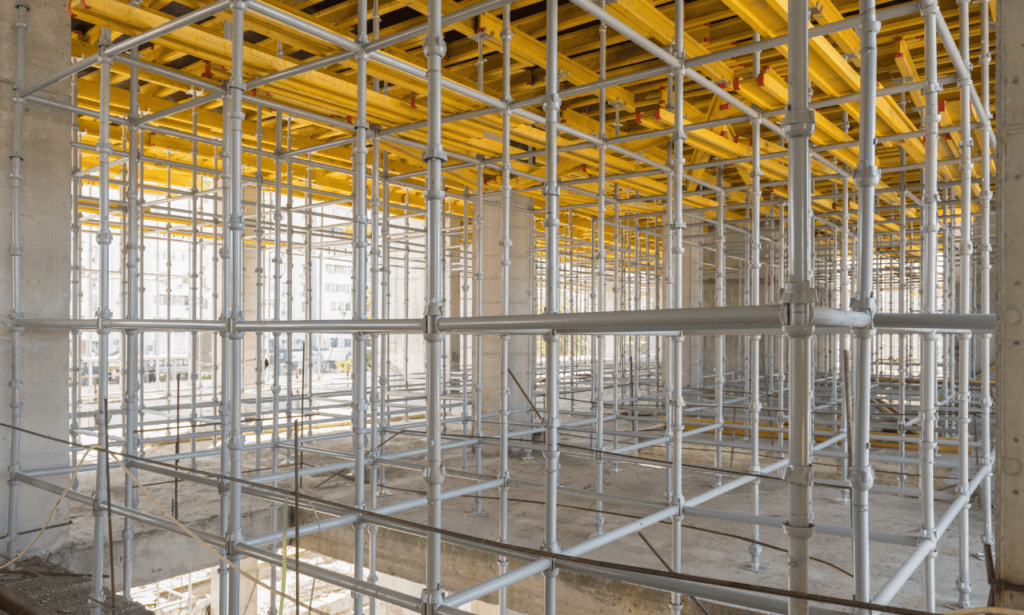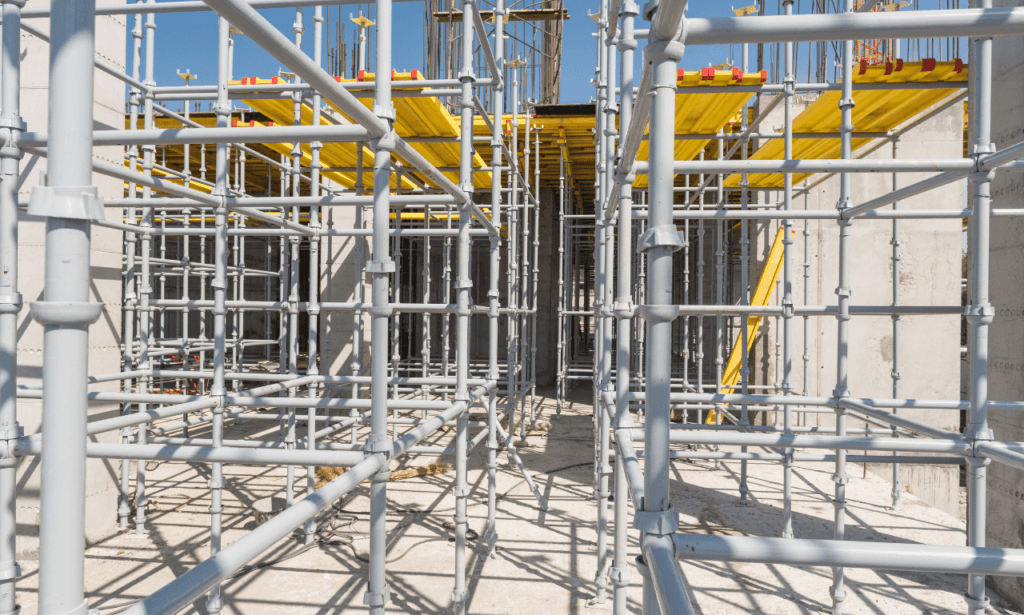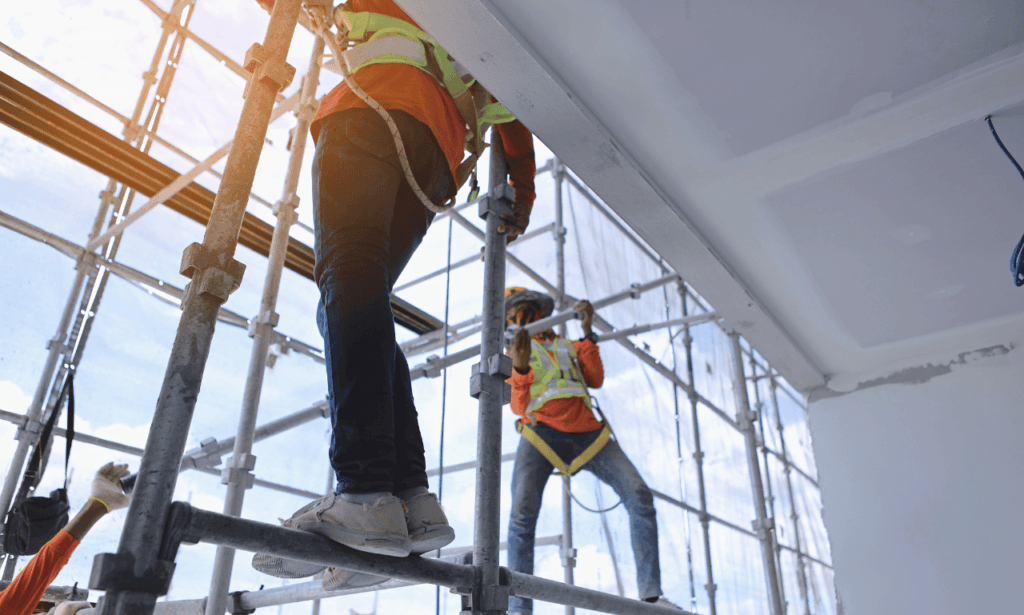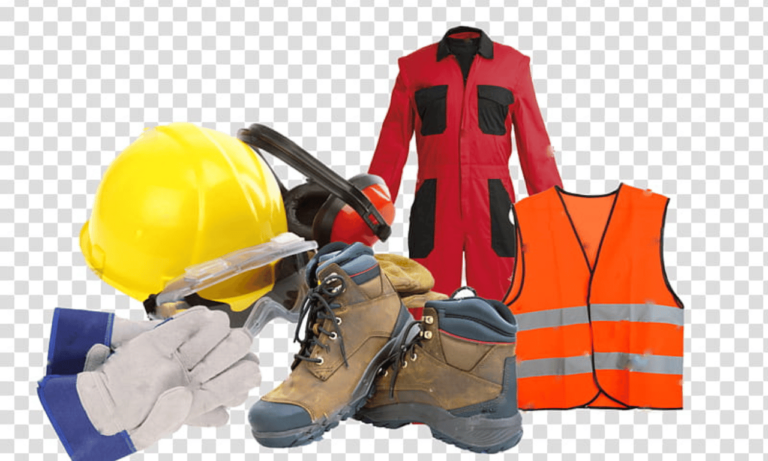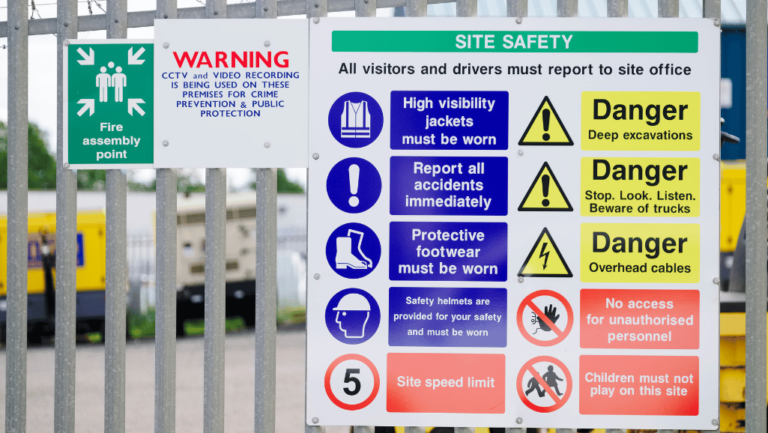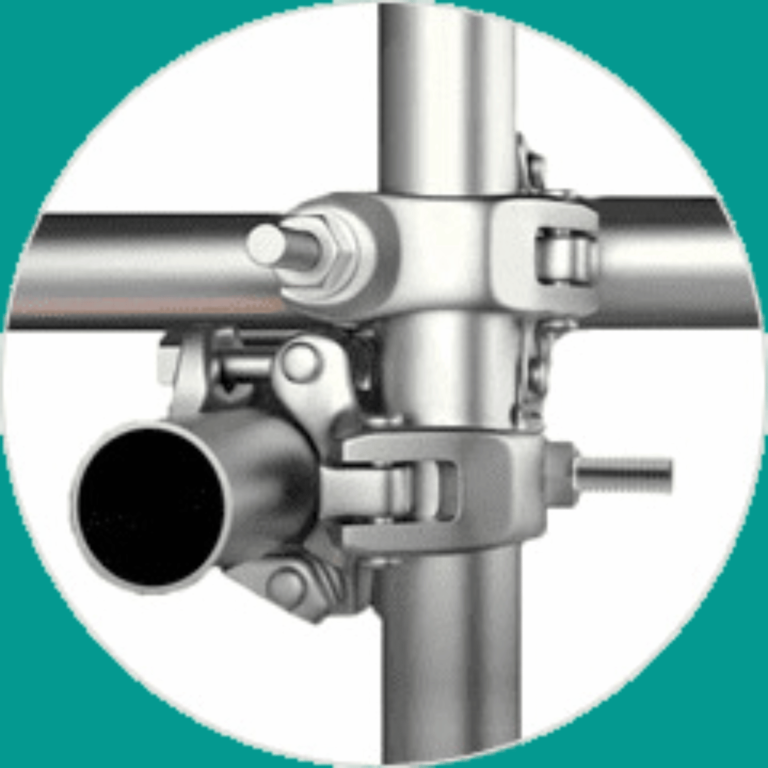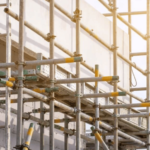Phone:
(+65)8319-0742
In the construction world, keeping workers safe is key. The Occupational Safety and Health Administration (OSHA) sets strict scaffolding requirements. These rules make sure scaffolds can handle their own weight and more without falling or moving.
It’s important to know how much weight a scaffold can hold to avoid accidents. OSHA says scaffolds must be strong enough to hold at least four times the heaviest load they’ll face, plus their own weight. This rule helps keep scaffolds stable, even when things get tough.
People who know a lot about scaffolding safety are very important, as they are responsible for hazard identification and ensuring scaffolds are set up right and are safe to use. OSHA makes sure these experts get the training they need to keep everyone safe. A competent person is essential in this process, as they have the knowledge and authority to identify hazards and ensure compliance with safety standards.
Key Takeaways
OSHA has established minimum load capacity standards for scaffolds to ensure worker safety and prevent accidents.
Scaffolds must be capable of supporting their own weight plus four times the maximum intended load without settling or displacement.
Proper scaffold design, construction, and regular inspections are essential for maintaining the structural integrity of scaffolds.
Competent persons play a vital role in overseeing scaffold safety, identifying potential hazards, and ensuring compliance with OSHA regulations.
Adequate training for competent persons is crucial for maintaining a safe work environment in scaffolding operations.
Competent persons must obtain OSHA certification to ensure they are qualified to oversee scaffold safety and compliance.
Understanding OSHA’s Scaffolding Load Capacity Requirements
Keeping workers safe on scaffolds is a big deal in construction. The Occupational Safety and Health Administration (OSHA) has set rules for scaffold load capacity. These rules aim to prevent accidents and injuries. OSHA says each scaffold must hold its own weight plus at least four times the maximum load it’s meant to carry.
To follow these safety rules, a qualified person with proper safety training must design the scaffolds. They must load the scaffolds as the design says. This means doing detailed engineering to figure out the scaffold’s weight limit and stability. Things like the quality of materials, design, and site conditions all play a part.
Minimum Load Capacity Standards
OSHA has set minimum load capacity standards for scaffolds:
Each scaffold and component must hold its own weight and at least 4 times the maximum load it’s meant to carry.
Each suspension rope must support at least 6 times the maximum load.
Not following these standards can lead to big fines. In 2023, OSHA’s fines for serious violations went up to $15,625 per violation. Fines for willful or repeated violations jumped to $156,259 per violation. Ensuring compliance with these standards often requires OSHA certification for those responsible for scaffold safety.
Factors Affecting Load Capacity
Several things can affect how much weight a scaffold can hold, including:
Quality of construction materials
Proper design and engineering
Site conditions (e.g., ground stability, environmental factors)
Regular inspections and maintenance
Contractors and workers need to know these factors and perform hazard identification to ensure scaffolds are safe. Following OSHA’s rules and best practices can greatly reduce accident risks. This makes the construction site safer for everyone.
Ensuring Structural Integrity of Scaffolds
Keeping scaffolds safe is crucial for worker safety and accident prevention. Good design, following rules, and regular checks are key. They help scaffolds hold their load.
Obtaining OSHA certification is crucial for those responsible for ensuring the structural integrity of scaffolds.
Proper Scaffold Design and Construction
Scaffold design is vital for safety. OSHA says scaffolds must hold their own weight and at least four times the maximum intended load. For tall scaffolds, a professional engineer must check the design.
The materials used are also important, and hazard identification during the design phase can help ensure they are strong enough to handle the stresses of use. Scaffolds made after 2000 need toprails between 38 and 45 inches tall. Older ones must be between 36 and 45 inches.
Regular Inspections and Maintenance
Regular checks and upkeep are vital. A skilled person must inspect scaffolds before and after work. They look for damage, corrosion, and overloading signs.
If problems are found, they must be fixed right away. Damaged parts should be replaced or fixed quickly. Sometimes, load tests are needed to ensure safety.
Employers must train workers on scaffold safety, and this safety training helps prevent accidents. By focusing on design, construction, and maintenance, accidents can be greatly reduced.
Scaffold Must Be Capable of Supporting At Least Standards
In the construction world, about 2.3 million workers (65% of the workforce) use scaffolds. OSHA compliance is key. The Occupational Safety and Health Administration (OSHA) sets rules for scaffold load bearing strength and weight tolerance to keep workers safe.
OSHA says each scaffold must hold its own weight and at least 4 times the maximum load it’s meant to carry, making hazard identification crucial for stability. This safety factor is vital for the scaffold’s stability. Following these industry standards helps prevent accidents and creates a safer work place.
Scaffold platforms are built with wood planks, fabricated planks, or decks. The wood used must be strong enough to carry a load of 1,500 lb-f/in2. Also, workers over 10 feet up need fall protection, with guardrails and crossbracing at specific heights. “Scaffolding violations consistently rank third on OSHA’s list of most frequently cited standards violations, highlighting the importance of adhering to these critical safety measures.” OSHA 29 CFR 1910.28 safety rules give detailed guidelines for scaffold safety. They cover how much weight scaffolds can hold, guardrails for safety, and the minimum width of walkways.
As modern scaffolding techniques improve, the construction industry must keep up. By following OSHA’s strict rules and using new technologies, the number of scaffolding injuries can be greatly reduced.
Consequences of Overloading Scaffolds
Overloading scaffolds can be very dangerous for workers and employers. When scaffolds carry too much weight, they can fail and cause scaffold accidents. These accidents put workers at risk and can lead to big fines and legal trouble for employers.
Scaffold Collapse and Worker Injuries
One big risk of overloading scaffolds is that they can collapse. This can make workers fall from high places, leading to serious injuries or even death. In 2021, 52 people died from falling off scaffolding, as reported by the Bureau of Labor Statistics.
Workers who survive scaffold accidents often face long-term health issues, underscoring the importance of hazard identification to prevent such incidents. They may deal with chronic pain, disability, and PTSD. These problems can greatly affect their lives and ability to work again.
OSHA Penalties for Non-Compliance
Employers who don’t follow OSHA’s scaffolding rules can face big fines. In FY 2022, scaffolding was the fifth most common OSHA violation. The fines can be as high as $145,027 for serious or repeated offenses (as of 2023). “Following OSHA standards could save up to 50 lives and prevent 4,500 accidents every year in construction.” To avoid fines and keep workers safe, employers need to focus on scaffold safety and ensure their competent persons have OSHA certification. This means:
Not overloading scaffolds with too much weight
Checking scaffolds regularly for damage or problems
Providing safety gear for workers on high scaffolds
Following OSHA rules when working near power lines
By taking these steps, employers can reduce the risk of accidents, protect their workers, and avoid expensive fines.
Best Practices for Maintaining Scaffold Load Capacity
Keeping the load capacity of scaffolds is key for scaffold safety. It helps prevent accidents on construction sites. Proper load distribution, regular maintenance, and training workers are essential. They help keep the scaffold strong and protect workers from falls and injuries.
The Bureau of Labor Statistics reports that unsafe scaffolding caused 3,400 injuries and 56 deaths in 2020. To lower these risks, scaffolds must support at least four times the maximum intended load. This includes workers, tools, equipment, and materials.
It’s important to distribute loads properly to keep scaffolds stable. The load capacity of scaffolds varies. Light-duty scaffolds can handle 25 pounds per square foot, medium-duty 50 pounds, and heavy-duty 75 pounds.
Platforms, planks, or decking should not bend more than 1/60 of their span when loaded. This prevents overloading the scaffold.
Regular maintenance and inspections are crucial for scaffold safety. Scaffolds need daily checks by a competent person and after any changes. Supported scaffold parts must rest on base plates and mud sills for stability. “Failure to provide fall protection is one of the most cited OSHA standards in scaffolding violations.” Training workers is also vital, and safety training helps them understand how to safely use scaffolds and identify hazards. A competent person should oversee setup, dismantling, and any changes to ensure safety.
Following these best practices and OSHA rules can greatly reduce scaffold accidents. It makes the workplace safer for employees.
The Role of Competent Persons in Scaffold Safety
Scaffolding is key in many construction projects, with about 65% of the industry using it often. Yet, scaffold accidents are a big worry, with OSHA noting 29,000 fall injuries each year. The role of competent persons in keeping workers safe is crucial, and obtaining OSHA certification is a key part of their qualifications.
A competent person knows how to spot and fix hazards on scaffolds. They make sure scaffolds are set up right and do regular scaffold inspections to keep the work area safe.
Responsibilities of Competent Persons
Competent persons have big responsibilities for scaffold safety. They include:
Doing detailed hazard identification and risk checks
Ensuring scaffolds follow OSHA rules when they’re built, taken down, or changed
Doing scaffold inspections often to find and fix problems
Teaching workers how to safely use scaffolds and protect against falls
Keeping records of inspections, training, and fixes
Training Requirements for Competent Persons
To be a competent person, one must get safety training and OSHA certification. This training covers many areas, such as:
OSHA rules for scaffolding
How to design, build, and keep up scaffolds
How to spot and assess hazards
Using fall protection systems correctly
How to inspect and document scaffolds
A competent person is not just a title; it is a responsibility to ensure the safety and well-being of every worker on a scaffold.
By training competent persons, construction companies can lower the chance of scaffold accidents. This helps build a safe work culture on their sites.
Innovations in Scaffold Design for Improved Load Capacity
The scaffolding industry is always changing. New technologies and materials are coming out to make scaffolds stronger and safer. High-capacity scaffolds are now made with lightweight composites and strong alloys. They can hold more weight without losing their shape.
Scaffold innovation has also led to modular designs, which aid in hazard identification and make setup faster and safer. These systems are flexible and easy to change on construction sites. They use parts that fit together well, making setup faster and safer.
Advanced Materials and Technologies
New materials like aluminum and fiberglass are being used in scaffolds. They are stronger but lighter than steel. This means scaffolds can hold more without being too heavy.
Fiberglass scaffolding also has special benefits. It doesn’t rust, keeps warm or cool, and can be recycled. This makes it good for the environment.
The use of advanced materials and technologies in scaffold design is revolutionizing the industry, and OSHA certification ensures these innovations meet safety standards. – John Smith, Scaffold Engineering Expert
Engineered Scaffold Systems
Engineered scaffold systems are another big step forward. They are made to fit specific needs of each project. They consider things like how much weight they’ll hold and the weather.
By using computer designs and special analysis, including hazard identification, engineers make scaffolds better. They make sure the scaffolds can hold more weight and are stable.
The construction world is focusing more on safety and doing things better. New scaffold designs are key to this. They help with big projects and keep workers safe. Using new materials, modular design, and engineered systems helps everyone on the job site.
Keeping scaffold load capacity safe is key for workplace safety and OSHA rules in construction. Most scaffolding accidents happen because of planking or support failures. It’s important to follow OSHA standards closely.
Scaffolds need to hold at least four times their maximum load. Suspension ropes should handle six times the maximum load. It’s crucial to design, build, and check scaffolds regularly to keep them safe.
Employers must help keep workers safe by training them well. They should follow rules about electrical power lines and keep the scaffold stable. Avoiding overloading and making sure the base is stable are important.
OSHA requires fall protectionfor workers on scaffolds over 10 feet high. Falls from lower heights can still cause serious injuries or death.
New scaffold technology can improve safety. By focusing on safety, following OSHA rules, and managing risks, companies can keep workers safe. This helps the company’s reputation and success in the construction world.
What is the minimum load capacity requirement for scaffolds according to OSHA standards?
OSHA says each scaffold must hold its own weight and four times the heaviest load it will face. This rule helps ensure scaffolds can handle unexpected loads, and OSHA certification ensures those responsible are qualified.
What factors affect the load capacity of a scaffold?
Several things can change how much a scaffold can hold. These include the materials used, how it’s designed, and the site conditions. It’s also important to have regular checks by someone who knows what they’re doing and can perform hazard identification.
What are the consequences of overloading a scaffold?
Overloading can cause scaffolds to collapse, leading to serious injuries or even death. Breaking OSHA rules can also lead to big fines, up to 5,027 per offense (as of 2023), highlighting the importance of safety training.
What are some best practices for maintaining scaffold load capacity?
To keep scaffolds safe, distribute loads evenly, maintain them well, and train workers. Follow the manufacturer’s instructions and don’t overload scaffolds. Also, get approval for any changes from someone who knows what they’re doing and has OSHA certification.
What is the role of a competent person in scaffold safety?
A competent person makes sure scaffolds are set up right and are safe. They check scaffolds often and can perform hazard identification to fix problems. They need special training from OSHA to do this job well.
How have advancements in scaffold design and materials improved load capacities?
New materials like aluminum and composite plastics make scaffolds stronger and lighter. Engineered systems are also designed for specific jobs, making them more stable. These changes make construction sites safer and more efficient, and OSHA certification ensures these advancements meet safety standards.
ent.


